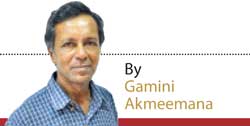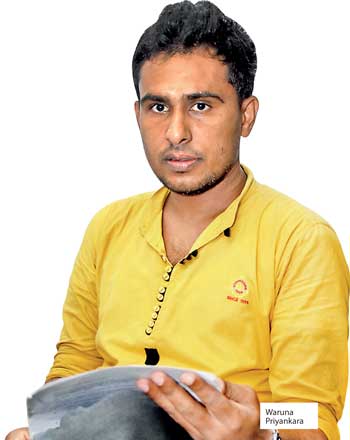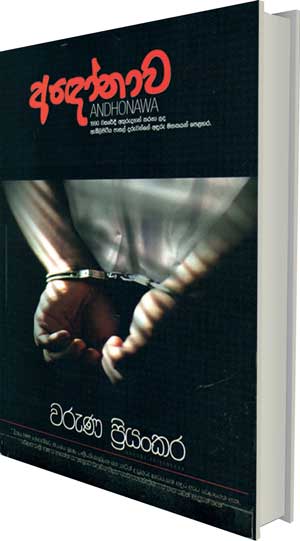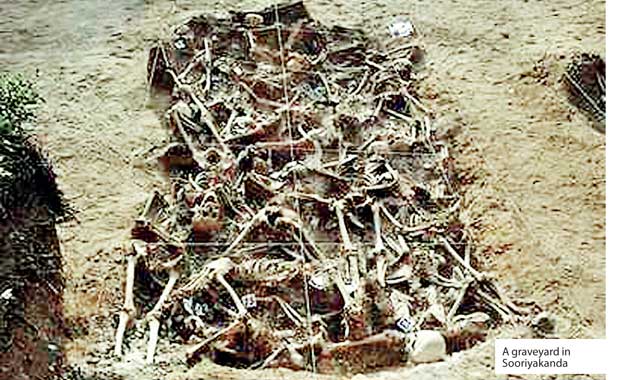Reply To:
Name - Reply Comment

The Sooriyakanda trial should have been a landmark in the judicial history of Sri Lanka. Nine individuals including army officers and soldiers were tried for kidnapping and disappearing more than 30 Advanced Level students from two schools in Embilipitiya during the anti-JVP crackdown in 1989-90. Only seven were convicted, and got away with relatively light sentences. A sculpture was created in Colombo in memory of the disappeared by a group of artists and activists in the following years. It was removed during the Rajapaksa government’s modernization drive. The Sooriyakanda ‘incident’ is
all but forgotten now.

While famous murders in our judicial history have been documented over the decades (Adlene Vitharana, Sathasivam, Pauline de Cruz and Dalrene Ingram cases come to mind) murder committed by employees of the State in the name of its defence (greater in number than those committed by individuals for personal reasons) have fallen behind a curtain of self-censorship. While the reasons for this can be multifaceted, the damage inflicted by the stinging silence on the accountability of the State and its organs of defence where citizens’ right to know is concerned remains incalculable.
In this context, ‘Andonawa’ (Wailing) by Varuna Priyankara is an invaluable book because it documents in detail the background, the setting and principal protagonists of this morbid but fascinating drama which concluded with an ineffectual trial. It’s a chilling account of how the State, judiciary and civil society missed a golden opportunity to rise to a higher level of accountability, and let things drift away instead, keeping a gaping black hole open for future politically-motivated murders and crimes.

To date, no evidence has been found to link the murdered students (the actual number is close to sixty) to the JVP or its armed wing, the shadowy DJV. The reason for the abductions, orchestrated by school principal Dayananda Loku Galappaththi, range from a love letter written by his son to a school girl to personal dislikes, student protests against the principal’s high handedness, and even a cricket match. A former woman principal said during the trial that Loku Galappaththi ordered her to make a list of the most active, talented boys in the school. They all disappeared.
This is a blood chilling portrait of a society in complete chaos. The most frightening thing is the State’s inability to punish the offenders according to the magnitude of their crimes. Equally frightening is the existence of all the conditions, criteria and tools necessary for similar crimes to occur in the future should Sri Lanka descend into political chaos once again. The signals were growing redder day by day in 2014 when regime change put a (perhaps temporary) halt to this appalling decent into darkness. The other major figure in this shadow play of demons is Col. Rohana Parakrama Liyanage.
Both him and Loku Galappaththi should have been case studies for psychiatrists of a type of personality who remain submerged in normal times, but rise like ogres during times of civil war and social chaos. Once vested with power beyond the law, these people can give free rein to their inundated blood lust. What remains to be determined is whether these two men (and others who acted as torturers at this detention camp) went beyond routine sadism into the darker realm freely inhabited by psychopaths and serial killers. But to the best of one’s knowledge, no such clinical study has ever been carried out, which shows just how undeveloped our academic research in this vital area is.

Evidence shows that Col. Liyanage forced his young captives to swallow nails and broken glass, and forced them to write suicide notes to their parents. He callously hands over such victims to their parents, on the condition that they should be returned to the camp after medical treatment. It is inconceivable that such pathological characters should have held high positions in the military long after the trial. He was acquitted due to mistakes made by the prosecution. One wonders if those mistakes were deliberate, as a female administrative officer to the prosecution unethically married the second accused (the principal’s son) just weeks after his acquittal.
Principal Dayananda Loku Galappaththi is a study in evil. His profile in this case – the bureaucratic listing of those schoolboys he wanted dead, and the duplicitous role of acting as go-between distraught parents and the abductors operating from neighbouring Sevana army camp – indicate a type of perverted personality hitherto unseen in Sri Lanka’s judicial history. A psychiatrist would list him as psychopathic due to his total lack of remorse regarding his victims. But his chilling bureaucratic indifference and paper work could also put him alongside the Nazis and their death camp victims, the only difference being that Loku Galappaththi was not motivated by ideological hatred. His hate sprang from a personal vendetta and egoism. It’s chilling to reflect that he had risen to be an assistant director of education after the murders were committed. According to the author, he is now masquerading as a kapuva (intermediary between man and god) in a Ratnapura Devalaya, and has lost none of his venom and ability to intimidate people.
The relatively undeveloped state of forensics such as DNA analysis has been cited as another reason for the mediocre trial. But murders have been successfully solved in this country for decades despite the lack of very advanced science. Foreign assistance was being offered, but was turned down. The problem lay not with the lack of a DNA lab. Rather, it was lack of political will.
The book is not without its faults. The language lapses into sentimentality at times, and it should contain an analysis of the trial and cross-examination along with a factual account of what took place. No background material of the military men involved is given. Despite these shortcomings, the author succeeds in bringing together hitherto unknown details of the kidnappings, the circumstances in which terror reigned in Embilipitiya during those dark months, the despair of victims and parents, and documents pertaining to the tragedy as well as photographs of the actual sites, including the notorious Sevana interrogation camp and the demonic school principal’s office.
The JVP and DJV too, should be blamed for this tragedy. The ferocious state counterattack using the armed forces, the police and shadowy para-military groups such as the ‘Black Cats’ came as a result of the mayhem caused by them in the name of radical social change. Those who opposed them even nominally were mercilessly punished or gunned down. Thereafter, the stage was set for mass murder by the state’s organs and their allies. In the name of restoring law and order, personal vendettas became common as anyone could be abducted, tortured and killed under the JVP label. The students of Embilipitiya died horrible deaths for this reason. In the final analysis, both the state and the JVP are responsible for their deaths, but the state is guiltier because it failed to make proper use of the law which it claims to have restored when the killers of Embilipitiya went on trial.
The young author of this engrossing book should be commended for his commitment to investigative journalism. Though not a journalist, his painstaking groundwork puts to shame the so-called ‘investigative journalists’ who write sensational books in Sinhala exposing the underworld, blending fact and fantasy without any factual and documented evidence. This book is lavishly illustrated with personal and court documents, letters and photographs of individuals and places. The author, a student of Embilipitiya Madya Maha Vidyalaya, is a political science graduate making a modest living by teaching the subject. He has published this work at his own expense and can be contacted on 0719597071.
PIX by Kushan Pathiraja